A Brief History of NgagyurNyingma College
Moreover, to propagate the study and practice on Buddhist views and tenets determined according to the profound realixation of Six Ornaments and Two Supreme Ones in general and specially of those of Ngaygyur Nyingma’s Two Charioteers (Rongzom Maha Pandita & Longchen Rabjampa), Minling Lochen Dharma Shri, Pema Gyurmey Gyatso the second Thron holder of Mindroling, Miphan Rinpopche, Gyalsey Zhenphen Choeki Nangwa, etc.., His Eminence Khokhim Rinpoche established the present Institute on 29th April, 1988.
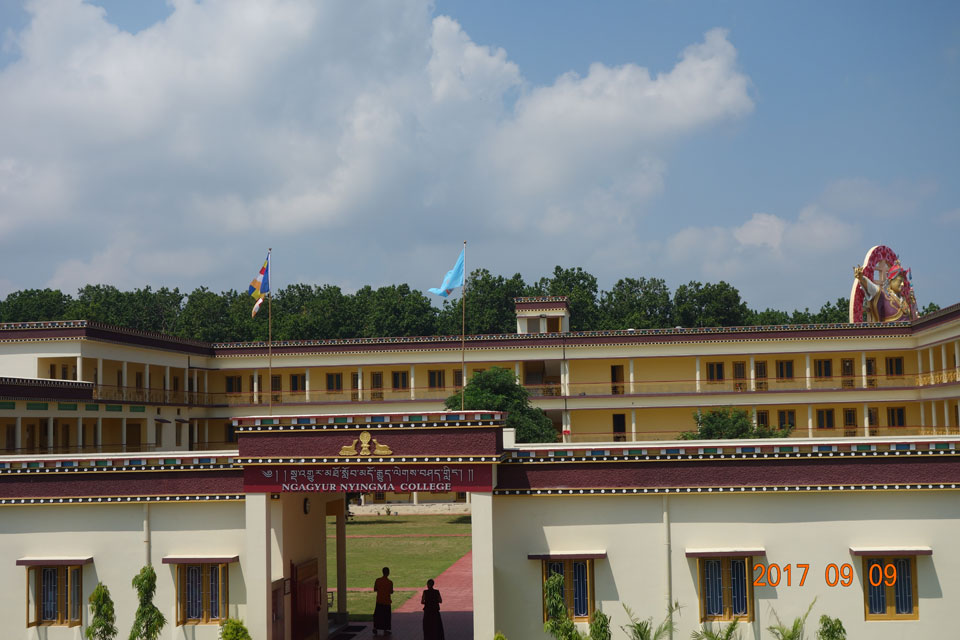
It was found to preserve the profound and unique Sutras and Tantras of the Great Vajrayna Doctrine through a Centre of learning and practicing. The college’s foundation stone was laid by His Holiness the 14th Dalai Lama with profound and extensive consecration ceremony. KyabjeMinlingThrichen Rinpoche, KyabjePenor Rinpoche, KyabjeMinlingKhenchen Rinpoche,KyabjeShechenRabjam Rinpoche,KyabjeKhokhim Rinpoche,UgyenTobgyal Rinpoche and also the Tulkus, Khenpos,Sanghas and many other distinguished guests from all four schools of Tibetan Buddhismwere present during theinauguration ceremony. We acknowledge the generosity of UgyenTobgyal Rinpoche for his selfless contribution to build a Shedra.
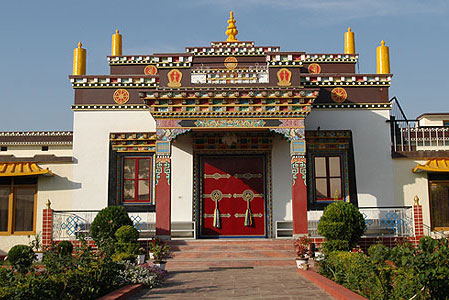
In 1990, H.E. Kyabje Minling Khenchen Rinpoche, Pecod Gyalsey Rinpoche Thubten Sherab Drakpa and Khenpo Lodoe Drimed and Khenpo Tenzin Samphel taught the first class of 25 students. Gradually the school was blessed with renowned abbots including late Khen Rinpoche Thubten Odzer, Khen Rinpoche Namdrol, Khenpo Konchok Odzer, late Khenpo Jampal Tsering, Khenpo Tandin Sithub, Khenchen Tsewang Rigzin, Khenpo Gelek Tenzin and Khenpo Kalzang Sonam.
Moreover, in 1993 during a visit to Mindroling Monastery, His Holiness the 14th Dalai Lama conferred the teachings on (CHOKCHU MUNSEL) “Dispelling the Darkness of Ten Directions.”Commentary on Guhya Garbha Tantra. The oral transmission on “Treasury of Precious Qualities” (YONTEN DZOED) was given by His Holiness Minling Thrichen
Rinpoche, while His Eminence Khokhim Rinpoche taught and gave oral transmission on the three conduct, “Corn Fruit of the Wish fulfilling Tree” (DOMSUM PAKSAM NYEMA) and the word of VajraPani, a commentary on Guyha Garbha Tantra (SANGDAG ZHAL-LUNG & SANGDAG GONG-GYEN) and a general view on Abhi-Samya Lamkara (DUETSI-NYINGKHU).
Gradually, students who have graduated from College were seeking to return and render the education service in their monastery and some abbots and educators were sent to Nepal, Bhutan and Sikkim etc. to spread the teachings respectively. Conditionally due to increasing numbers of students in the monastery, the compact and limited space and rooms became the concerning issue.In year 2012, H.E. Kyabje Minling Khenchen Rinpoche was obliged to construct the new hostel for students and further plan to build the College’s Shrine room for the whole Sangha to gather for the Sadhana, a library and etc. By now the hostel for the students is perfectly completed and combination of College’s Shrine Room and library is yet to build. In-short, the minimum service for theprevalence of Teachings of Victorious one and to fulfill the aspirations of supreme holders of the teaching has been made by listening, contemplating and meditating on scriptural text of Sutras, Tantras, Art and Science of Buddhism.
A series of events in Ngagyur Nyingma College for a year
After the vacation,it’s mandatory for everyone to report on time which is fixed on 30th of 3rd month of the Tibetan calendar. Vajrasattva ceremony is performed for seven days starting from 3rd of the month. On 5th the administration conducts an Entrance Examination for the new comers who come for direct admission to the college.The applicants should pass the exam with the minimum marks allotted.
The Annual Result is declared on 10th in presence of H.E. Kyabje Minling Khenchen Rinpoche, H.E. Kyabje Khokhim Rinpoche, Khenpos, Lopons and all the students, the certificates are awarded to each individual who claimed first and second position. The prizes, compliments and great applause are also imparted to those students who have memorized 50 pages and more. An exchange annual executives like chairman, secretary, disciplinarian, etc. is also announced in the gathering.
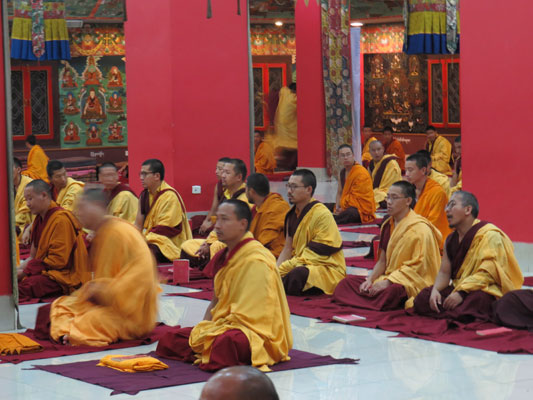
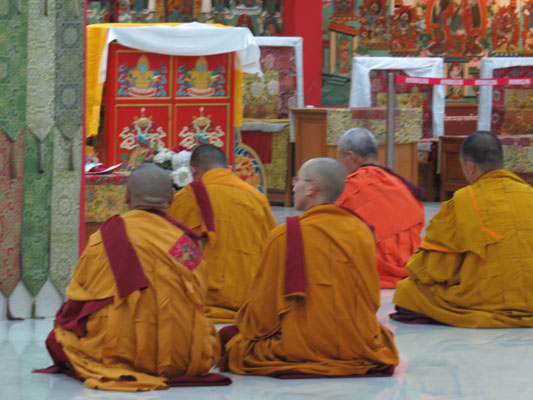
Subsequently, H.E. Kyabje Khokhim, H.E. Kyabje Minling Khenchen and official Khenpos deliver speeches on profound and vast view of discipline which is to be practiced at all times and how to train oneself on the path which is so essential.
Generally for all sentient beings and particularly dedicating to dispel the obstacles of Ngagyur
Nyingma College, prayers (Bar-Sam-Drol Sum, Dhug-Sher-Seng Sum and Solkha etc…) are recited on the basis of a divination specified by Kyabje Rinpoches. In fact the academic session starts from the very auspiciousday of 15thof Vaisaka Month which continues till 25th of 11th month of the Moon calendar within which the whole syllabus has to be covered. The scheme and schedule of the syllabus are implemented according to what is mentioned in the Law Book of College known as (Neten Zhalung) "Words of Firm Rules and Regulations".
Maha Pernirvana Anniversary of Jamgoen Mipham Rinpoche.
On 29th of Vaisaka Month, the Supreme Jamgoen Mipham Rinpoche has displayed the adornment of Rupa-Kaya disappearing into the space of Dharma-Dhatu inorder to tame those sentient beings who holds the wrong view of permanence. At this very auspicious day Khenpos, Lopons, Tulkus and all students gather to commemorate the day besides organizing the profound and peaceful ritual of Manjushri which is the Mind Treasure discovered by Mipham Rinpoche himself with a vast and extensive feast offering of both imaginative and material objects. In the evening, the students devote and participate in exposition, debate and composition of sublime Dharma in the form of clouds of offering as tribute for his gratefulness and to fulfill the heart consideration of him. With this, the Maha Pernirvanaof Jamgoen Mipham Rinpoche is preserved and reckoned.
Trel-Dah Tse-Chu (festival of tenth day of Fifth month)
On 8th 9th and 10thday of the 5th month, the grand offering of Ganachakra from the profound treasure of Unsurpassable Essence of all Secret (Lama Sangdue) is conducted annually.
Out of Three Basic Practices, 1st So-Jong"Fostering and Confessing"
Thus, the great master, renowned as the second Buddha said, "Foster perfectly all positive deeds, confess perfectly all the negative deeds. Reasonably fostering the positive deeds and confessing the negative deeds were taught by Tathagatha (one who has reached the suchness)". Therefore as it is said, harbor the knowledge of all positive acts with countermeasure and abandon all negative deeds by confession is called asSo-Jong. With every half month on an increasing phase of the Moon and decreasing Phase of the moon, a So-Jong is held where gathering of Sanghaconstantly practices the sublime Dharma of Vinaya which is the root all teachings.
2ndSummer Retreat.
In sublime Dharma of Vinaya, It says "The monks who are abiding in summer retreat, traveling to the country side forged heretic to blame and abuse which then lead to the regulation of early summer retreat". From the Vinaya text called Rosary of Continues Flower, "like wheat from the first date of the month, every summer retreat is considered important, because it is the month of discipline, from the first date of the month as renowned".
It begins from 15th of 6th month to the end of 7th month of Moon calendar. For the duration of one and half month, we take an oath to abide and dwell early summer retreat in accordance withVinaya text. Every morning the whole Sangha without an exception assemble to recite morning prayers(Jun-Chaksumpa)persistently.
During the whole period of summer retreat, every Sunday evening at 4 o’clock all students gather to make arguments and discussion on important topics that are composed by senior students based on the scriptures. And every Monday, at 7 pm, the junior students explain the root text according to the respective class as a part of oral test. The students are divided into two groups and the vital points of both Sutras and Tantras are being debated and investigated thoroughly.
3rd Gagyey
Gagyey, one of three principal ceremonies performed in order to purify the Pratimoksha precepts is held after summer retreat.According to the excellent doctrine of Pratimoksha, the people of the nearby town should be informed about the release of summer retreat before seven days and the monks should start maintaining their monastery by cleaning the surroundings. The monks should also prepare residence and food for people from the townthat will come to attend the teaching session. During the 28th evening of 7th month, the abbot of the summer retreat and the gathering of monks should stay long night performing exposition, debate and composition. In the following morning, all the monks who have been in summer retreat should assemble to mutually perform the ritual of forgiveness and thus happily advance to the ritual of Gagyey. The things received as Alms during summer retreat are equally distributed to the Sanghagathered.On 30th, to discard the attachments to the object and the place,the abbot of summer retreat leads the sangha to the distance of about two miles from the monastery to the town and following this event, five days of holiday is declared.
Kama Drupchoe (The Grand Sadhana of Kama.)
The enhancement ritual (Tagoen) of KamaDrupchoeis held on the13th of 9th month of Moon calendar and to bless the sight, a holy dance called "Tsa-Chham" is performed. It is accompanied by several rituals like Sa-Chok(inaugurating the site), Gyen-Goe(offering of ornament) and the ritual of Mandala.
The main ritual will begin on date 17thwhich will be held for seven consecutive days. The ritual of Kama Drupchoeis sub-divided into five categories which are Tshok-Chen Duepa, JuthrulZhiwa, Juthrul Throw, Yangdak and Lung-Lug Tsedrup. On date 22nd, a mask dance called "Gar-Chham" is performed. It is followed by a day of fire offering of four different types (Zhe, Jey,Wangand Drak). Finally, the Drupchoewill be concluded with Mar-MoeMonlam(butter lamp prayer.)
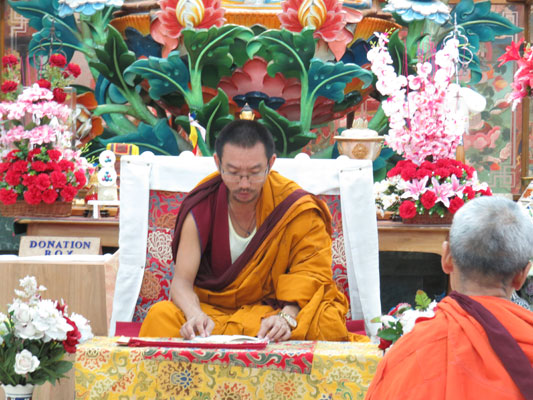
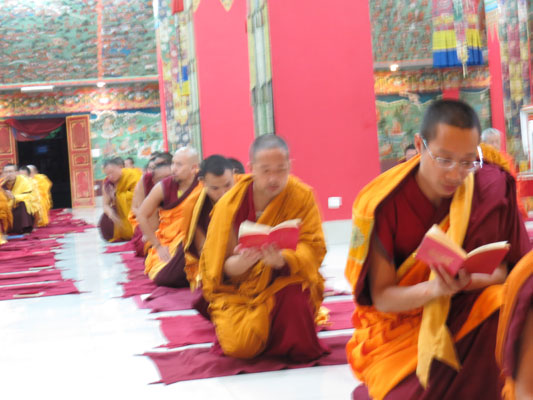
Rang-Jong (Self-Study)
Every yearRang-Jong(self-study) starts from date 25 of 10th month till date 9 of 11th month of Moon calendar. In these fifteen days of Rang-Jong,the regular timing and schedule is same as before except the normal classes and debate.
Monthly Test
Since it is a tradition of College, Monthly test is conducted for the junior classes by respective class teacher every month after completion of each syllabus. The sole reason for conducting monthly test is to train the beginners for the annual examination. The senior students don’t have to appear for monthly test.
Annual Examination.
The criteria that the students must fulfill before they appear for examination are:
- The students are not allowed to appear for exam in the year if Khanpos, Lopons and Disciplinarian etc. condemn students of his misconduct.
- All students must hold 80% of attendance except for those who have got specific permission from the monastic administration.
- All students must finish memorizing the root texts that they are assigned with before Rang-Jong (self study).
- All students must pay/clear the penalties that they have made by violating the rules and regulations of the monastery.
To summarize, the students should be clean of all misconducts or else, they are not allowed to sit for their examination.
The students at minimum should score 40 percent in core subjects and 33 percent in elective subjects. The result mark sheets are categorized in three groups according to the marks scored by individual student. Students who hold 60 percent and above are placed in first division,above 50% are categorized in second division and rest falls under third division. If a student fails repeatedly for two times in a same class, he is terminated from the college and send back to Dratsang.
The first exam is held on date 10th of 11thmonth followed by next exam after two days until 25th of the same month. The whole Sangha members go out for refreshment from the money collected from the penalty.
Nyingma Monlam Chenmo and vacation.
The whole Sangha, including the Rinpoches, Khenpos and teachers move for annual NyingmaMonlamChenmo on the 28th day of 11th month of Tibetan Calendar. Returning from Bodh Gaya after hosting the Grand ceremony for Ten days the monks conduct several rituals like the annual death anniversary of Dharma King, the Omniscient LongchenRabjampa held on 18of last month of moon calendar. OtherDrup Chen(Great Accomplishment) such as Shinjey Tor-Zor, ThukjeyChenpo, KagyedDrup Chen and Tse-Chu are also conducted yearly. Such programs are held till the 11th of 2nd month and after it all students are given a vacation of about two months in which they can go anywhere they like.
The Management and Administration of Ngagyur Nyingma College.
Assaid in the Sutras, “The Bodhisattava Maha Bodhisattava fulfills the wishes of all sentient beingswho desire food for hunger, water for thirst, cloths and bed-clothes for cloth less and medicines for sick”. Therefore, due to unsurpassable kind aspirations and blessings of late Thrichen Rinpoche, the Owner of Great Ocean of Secret Teachings, H.E. MinlingKhenchen Rinpoche and H.E.Khokhim Rinpoche, all the Sangha are provided with foods, lodging and set of uniform moderately every Year.
The selection of executives for the management of the institute is held on date 8 of 4th month. The selection is made in the kind presence of H.E. Khenchen Rinpoche, administration and other senior officials of the college. After mutual discussion, a new committee is formed with new members in it. The committee consists of a Chair-Man, Assistant Chair-man, Secretary, Accountant, Chief Disciplinarian and an Assistant Disciplinarian.
Under the kind guidance of H.E. Khenchen Rinpoche and his management on various vital fields such as the quality of education, code of conduct and the financial necessities of the institute, the administration takes active part in strengthening the rules and regulation of the college. It also works to enhance the quality of education through various means such as inviting learned scholars and teachers from outside. The administration strives for the development of relationship with other institutes and monasteries. Khenpos and lopens of the institute not only teach the lessons but also supervise and counsel on daily code of conduct.
The Assistant Chairman acts on behalf of the Chair-Man if the Chair-Man is out of the monastery. The applications and document works are mainly looked by the Secretary. The Accountant keeps record of the transitions made by the institute and keeps the money received from people. He is also responsible for the management of financial transitions and expenses made by the canteen and the library.
The Chief Disciplinarian and the Assistant Disciplinarian are responsible to look after the daily routine of the college. They should frequently check if the students are following the rules and regulations properly. To summarize, all members of the committee work hard despite of all difficulties until the end of the year with glorious result.
Canteen
The canteen helps in providing the general things/items to the student in a quick and easy way. It helps the student refrain from regularly visiting the nearby town where by saving a great deal of time and energy.
Auditor
They keep monthly account of out-going and in-coming money from the treasurer, disciplinarian, Canteen, Library, etc. At the end of the year, they prepare a final draft of the account for the particular year and announce it to the gathering.
Board of Editorial
An Editorial committee is formed by the administration of the institute. The students who are good and interested in the field of Composing and Editing are selected as the Member of the committee and a senior Abbot/teacher is appointed to look after the function of the committee. Their role is to compose articles like Biographies, History, Poetry, etc. and they are responsible for publishing magazines and other Buddhist Texts.
Mipham Doeched Committee
This committee is formed specially to carry out the program held on the Maha-Pernirvana Day of JamgoenMipham Rinpoche. Their role is to collect donations for the program and supervise the ceremony held on the day. They also provide veneration and offerings to the gathered Sangha and if there is remained money of the collected donation, they submit it to the administration to be used for the development plans of the institute.
Life releasing committee
The administration appoints an abbot/teacher/tulku as the director of this group and with help from the students of the final year, theytake a responsible step to ransom the lives of great number of fishes with sum of money collected from the donation and dedicate these virtuous act to perpetuate the life of His Holiness the 14Th Dalai Lama, other Great sublime beings and the holder of teachings and to widespread their Dharmic activities. They are eventually released into the great holy river of Ganga near Reshikesh valley.
Characteristics of Chorpoen (Revision Tutor)
A Chorpoen is any student above 7th standard who gives tuition to the students of the junior classes on main subjects already taught by an Abbot or a teacher. The criteria on the basis of which a Chorpoen is selected are: He should have completed the sixth standard. He should be pure of discipline, vow and acquired first division in exams for at least five times. He should have scored more than 50% on the skill of preaching that is held during Summer Retreat (Yarney). The student who fulfills the criteria is selected for election done by the general students. Finally after a thorough inspection done by the administration, a number of Chorpoens are appointed and they are allocated with subjects to be taught. After the entitlement of Chorpoen, they should be considered as a genuine tutor despite of the difference in the subject they teach.
Characteristics of Teacher (Lopon)
It is un-doubtfully necessary for a student to go through the post of Chorpoen to be eligible for the post of Teacher. On top of it, he should gain the Vote minimum of 50% from the students. The final decision will be made by the administration and after that, the names of the newly appointed teachers will be declared. The officially appointed teachers are allowed to teach in the institute and as well in the primary school of the monastery.
The Criteria for an appointment of Abbot (Khenpo)
One has to successfully complete the nine years course of studying the profound Treatises of Noble ancient Masters of India and Tibet and has to be well versed in these texts. Three years of experience as a Teacher is the minimum requirement while one also has to be pure in discipline and must hold the Vow of Bhiksu (fully ordained monk). Self-enriched with empowerments and teachings, strong determination in daily practices, having good behavior, genuine sense of affection towards Buddha’s Teachings in general and special care and affection towards the lineage from which one has learned are counted.
If one is qualified with the above criteria, the administration and Rinpoche takes a final decision and choosing an auspicious day, the whole Sangha led by Rinpoches confer the designation of professor (Khenpo) as recognition for mastering the profound Buddhist Treatises on both Sutra and Tantra.
Conferring of status and certificate.
For the first three years, the syllabus focused on is Vinaya texts and its treaties, Abhidharma(Phenomenology) in fourth and fifth standard, Sutra (Sets of Discourses) in sixth and seventh year. In short, for seven long years, study on sect of Sutra is emphasized. Thus, certificates for mastering Vinaya, Abhidharma and Sutra are awarded.
In the final two years both upper and lower treaties of secret Tantric are studied thoroughly. Thus, recognition of profound scholarship in Tantrayana entitled as wisdom bearer is awarded.
